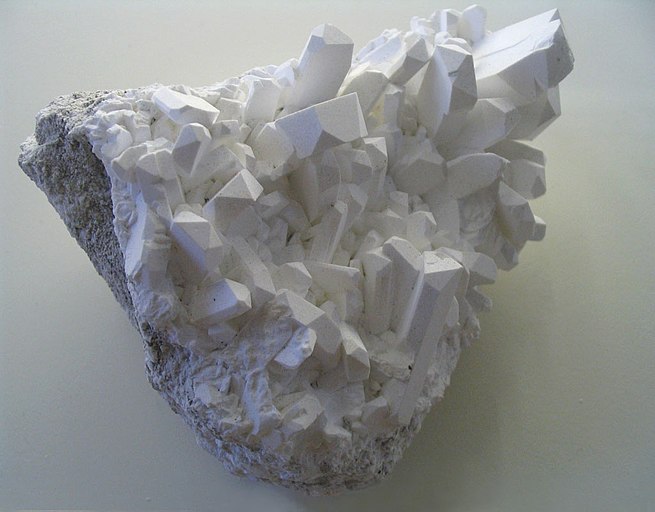
Main Difference
The main difference between Borax and Boron is that the Borax is a boron compound, a mineral, and a salt of boric acid and Boron is a chemical element with the atomic number of 5.
-
Borax
Borax, also known as sodium borate, sodium tetraborate, or disodium tetraborate, is an important boron compound, a mineral, and a salt of boric acid. Powdered borax is white, consisting of soft colorless crystals that dissolve in water. A number of closely related minerals or chemical compounds that differ in their crystal water content are referred to as borax, but the word is usually used to refer to the decahydrate. Commercially sold borax is partially dehydrated.
Borax is a component of many detergents, cosmetics, and enamel glazes. It is used to make buffer solutions in biochemistry, as a fire retardant, as an anti-fungal compound, in the manufacture of fiberglass, as a flux in metallurgy, neutron-capture shields for radioactive sources, a texturing agent in cooking, as a precursor for other boron compounds, and along with its inverse, boric acid, is useful as an insecticide.
In artisanal gold mining, the borax method is sometimes used as a substitute for toxic mercury in the gold extraction process. Borax was reportedly used by gold miners in parts of the Philippines in the 1900s.Borax was first discovered in dry lake beds in Tibet and was imported via the Silk Road to the Arabian Peninsula in the 8th Century AD. Borax first came into common use in the late 19th century when Francis Marion Smith’s Pacific Coast Borax Company began to market and popularize a large variety of applications under the 20 Mule Team Borax trademark, named for the method by which borax was originally hauled out of the California and Nevada deserts in large enough quantities to make it cheap and commonly available.
-
Boron
Boron is a chemical element with symbol B and atomic number 5. Produced entirely by cosmic ray spallation and supernovae and not by stellar nucleosynthesis, it is a low-abundance element in the Solar system and in the Earth’s crust. Boron is concentrated on Earth by the water-solubility of its more common naturally occurring compounds, the borate minerals. These are mined industrially as evaporites, such as borax and kernite. The largest known boron deposits are in Turkey, the largest producer of boron minerals.
Elemental boron is a metalloid that is found in small amounts in meteoroids but chemically uncombined boron is not otherwise found naturally on Earth. Industrially, very pure boron is produced with difficulty because of refractory contamination by carbon or other elements. Several allotropes of boron exist: amorphous boron is a brown powder; crystalline boron is silvery to black, extremely hard (about 9.5 on the Mohs scale), and a poor electrical conductor at room temperature. The primary use of elemental boron is as boron filaments with applications similar to carbon fibers in some high-strength materials.
Boron is primarily used in chemical compounds. About half of all boron consumed globally is an additive in fiberglass for insulation and structural materials. The next leading use is in polymers and ceramics in high-strength, lightweight structural and refractory materials. Borosilicate glass is desired for its greater strength and thermal shock resistance than ordinary soda lime glass. Boron as sodium perborate is used as a bleach. A small amount of boron is used as a dopant in semiconductors, and reagent intermediates in the synthesis of organic fine chemicals. A few boron-containing organic pharmaceuticals are used or are in study. Natural boron is composed of two stable isotopes, one of which (boron-10) has a number of uses as a neutron-capturing agent.
In biology, borates have low toxicity in mammals (similar to table salt), but are more toxic to arthropods and are used as insecticides. Boric acid is mildly antimicrobial, and several natural boron-containing organic antibiotics are known. Boron is an essential plant nutrient and boron compounds such as borax and boric acid are used as fertilizers in agriculture, although it only required in small amounts, with excess being toxic. Boron compounds play a strengthening role in the cell walls of all plants. There is no consensus on whether boron is an essential nutrient for mammals, including humans, although there is some evidence it supports bone health.
-
Borax (noun)
A white or gray/grey crystalline salt, with a slight alkaline taste, used as a flux, in soldering metals, making enamels, fixing colors/colours on porcelain, and as a soap, etc.
-
Borax (noun)
The sodium salt of boric acid, Na2B4O7, either anhydrous or with 5 or 10 molecules of water of crystallisation; sodium tetraborate.
-
Borax (adjective)
Cheap or tawdry, referring to furniture or other works of industrial design.
-
Boron (noun)
The chemical element (symbol B) with an atomic number of 5, which is a metalloid.
-
Boron (noun)
A single atom of this element.
-
Borax (noun)
a white compound which occurs as a mineral in some alkaline salt deposits and is used in making glass and ceramics, as a metallurgical flux, and as an antiseptic.
-
Borax (noun)
good-natured teasing or ridicule; banter
“they take a bit of borax, but that is part of the job”
-
Boron (noun)
the chemical element of atomic number 5, a non-metallic solid.
